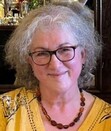Debbie Young's Blog, page 11
February 22, 2023
An Interview with Helen Hollick, Author of Cosy Crime and Much More!
In this week’s post, I’m pleased to share an interview with my author friend Helen Hollick, who during lockdown took to crime! Cosy crime, that is (or cozy, if you’re on the other side of the Atlantic from us).
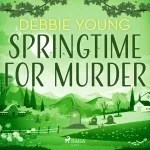 Also new this week: an interview with me has just gone live on the website of Saga Egmont, the award-winning audiobook publisher currently in the throes of publishing audiobooks of the first seven Sophie Sayers Village Mysteries. Click here to read my interview on Saga Egmont’s website. (Link will open in a separate window.)
Also new this week: an interview with me has just gone live on the website of Saga Egmont, the award-winning audiobook publisher currently in the throes of publishing audiobooks of the first seven Sophie Sayers Village Mysteries. Click here to read my interview on Saga Egmont’s website. (Link will open in a separate window.)
In case you’re not already familiar with Helen Hollick and her work, here’s an introduction.
Helen Hollick’s Author Bio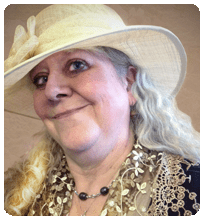 Helen Hollick
Helen HollickFirst accepted for traditional publication in 1993, Helen became a USA Today Bestseller with her historical novel, The Forever Queen (titled A Hollow Crown in the UK) with the sequel, Harold the King (US: I Am The Chosen King) being novels that explore the events that led to the Battle of Hastings in 1066. Her Pendragon’s Banner Trilogy is a fifth-century version of the Arthurian legend, and she writes a nautical adventure/fantasy series, The Sea Witch Voyages. She has also branched out into the quick read novella, ‘Cosy Mystery’ genre with her Jan Christopher Murder Mysteries, set in the 1970s, with the first in the series, A Mirror Murder incorporating her often hilarious memories of working as a library assistant.
Her non-fiction books are Pirates: Truth and Tales and Life of A Smuggler. She lives with her family in an eighteenth-century farmhouse in North Devon and occasionally gets time to write…
Now, on with the interview …Debbie: Your latest fiction writing venture has been quite a departure from your previous historical novels and historical pirate fantasy – what made you decide to sidestep into cosy mystery?
Helen: Well, to be honest – it’s all your fault, Debbie! I found myself hooked on your Sophie Sayers series, and during the first Covid lockdown I found myself wondering if I could also write a cosy mystery. I had been thinking about setting a novel in a library for quite a while, but had never got beyond the ‘hmm, I wonder?’ stage.
Lockdown created an urge to do something different, so the ‘thinking about it’ became ‘DO it’!
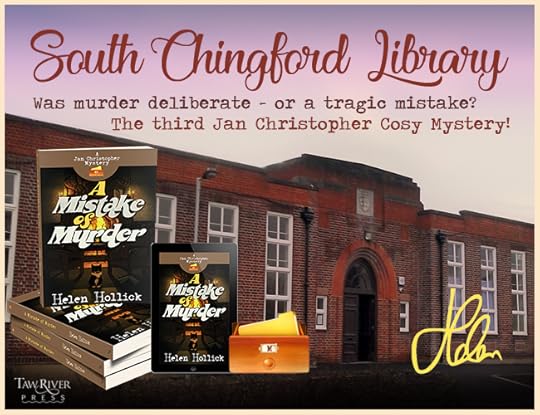 Helen’s new series was a satisfying lockdown project
Helen’s new series was a satisfying lockdown projectDebbie: Who are your favourite cosy crime authors and why?
Helen: You are top of my list (I am being truthful, not just currying favour!) I also quite like Helena Dixon’s Miss Underhay mysteries, Katie Gayle’s Julia Bird Mysteries, Rhys Bowen’s Constable Evans, and the Eve Mallow mysteries by Clare Chase. I quite enjoy Pauline Barclay’s new Gardner & Chattaway series as well. I like these because they are easy reads, the sort of books to go to bed early with when there’s nothing much on TV. I snuggle under the duvet with my Kindle, let the cat finish her ‘piano playing’, then curl up beside me. My favourite teddy is propped under my arm, and sometimes there’s a box of chocs to hand…
Debbie: What are the particular challenges of writing in this genre? What do you like most about it?
Helen: My intention, when initially setting out, was to enjoy myself – and hope potential readers would have fun too. So I try to have some humour mixed in amongst the serious murder mystery stuff. I hadn’t intended to do much detailed research – that silly idea soon went out the window! I discovered that my memory wasn’t as good as I thought it was, so I had to research the 1970s just as diligently as if I was researching the 1770s. It is quite challenging to keep a balance between writing the serious business of a crime, adding a touch of romantic development between the main characters and slipping in those touches of humour, whilst ensuring that the pace keeps steady and that ‘page turner’ quality isn’t lost.
Debbie: Aspiring writers are often told to “Write what you know” – yet this is the first series that can have drawn on your own life experience! To what extent do you agree with that advice?
Helen: I started off with writing historical fiction, and I’ll never forget my ten-year-old daughter saying to me when I was first accepted for publication back in 1993, “Mum, do you remember any real stone-age people?” Er… no, I’m not quite that old, and I don’t remember any Romano-Britons (My King Arthur Trilogy), I wasn’t there at the Battle of Hastings and I’ve never sailed aboard an eighteenth-century pirate ship! Apart from what I watch on TV (Vera, Foyle’s War, Lewis etc.,) I know nothing about murder or police procedure, so no, you do not need to write what you know about, that is where good research comes in.
BUT … historical fiction (or any fiction, come to that!) is not merely a case of stringing a series of ‘this, this, this’ facts together; an author has to create a readable story, and the best way to do that is to make use of what you do know in between all the made-up and well-researched bits.
Bring your characters to life by tapping into your own experiences. Use your pleasures or fears, your interests or knowledge. Although I do not personally know about the fifth, eleventh or eighteenth centuries, I do know about relationships, doubts, confidences … and horses. Horses feature quite often in my books. Except for the pirate stories, unless you include sea horses!
For what I ‘know’ in my Jan Christopher series: read on…
Debbie: This series is partially set in a 1970s public library. Tell us more about your former career as a library assistant. How different was the role in the ‘70s, compared to in the 21st century?
Helen: One reason why I decided to write my cosy mystery series was the fact that I wanted to make use of my twelve or so years of working as a library assistant during the 1970s. I have a wealth of anecdotes to draw upon, and, as with the above question, I do know about working in a library. However, writing about this period brought home just how much has changed since then.
No computers for a start. No mobile phones – we had one telephone at home which was in the hall, so no privacy for conversations with a boyfriend. One black-and-white television which Mum and Dad had priority over. (I remember being devastated because Dad wanted to watch something that was on at the same time as the Beatles were live on Top Of The Pops.)
As for the library – again no computers, everything was done by hand with cards and tickets. Filing index cards was a boring job. Who remembers those wooden filing cabinet draws? When a book was borrowed the individually numbered ‘charge card’ was taken from the pocket at the front of the book and slipped into the borrower’s ticket (yellow for adults, pink for juniors. I can’t remember if there was another colour for pensioners? Blue?) These were rough-sorted into pigeon holes along the wooden counter according to the charge card numbers, then, of an evening, put into numerical order in long trays. Once in order, the day’s ‘issue’ was counted. I got quite fast flicking through the tickets to count them.
When books were returned the date on the date label was checked, the corresponding tray found, and then the charge card in its ticket located. All of which worked fine apart from cards that were in the wrong order, or cram-full date labels which should have had a new one put in but hadn’t. Usually because the glue pot was empty.
As an assistant (note: I was only an assistant, not a qualified librarian,) the work was quite hard. Books weigh a lot, and I reckon we walked a good few miles each day round all those library shelves! The librarian was Mr Xxx, we used his surname, never his first name. And dealing with the rudeness of some members of the public was not always a pleasant task. Unfortunately, I doubt that bit has changed much. The public is still capable of being rude.
 South Chingford Library (© Alison Morton)
South Chingford Library (© Alison Morton)Debbie: Please tell us a little about Jan Christopher’s background and character.
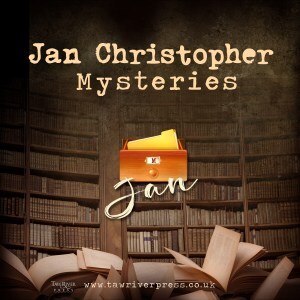 Helen: Jan’s full name is January, for the month she was prematurely born – but she rarely uses it. Her father was a detective inspector in the local police force and was fatally shot when Jan was a small child, with her mother ‘disappearing’ soon after. (No spoilers: I’ve not said much about her Mum or Dad – yet. That’ll be for A Memory of Murder, when I get round to writing it.) So Jan was adopted by her father’s brother, DCI Tobias Christopher and his wife, Madge.
Helen: Jan’s full name is January, for the month she was prematurely born – but she rarely uses it. Her father was a detective inspector in the local police force and was fatally shot when Jan was a small child, with her mother ‘disappearing’ soon after. (No spoilers: I’ve not said much about her Mum or Dad – yet. That’ll be for A Memory of Murder, when I get round to writing it.) So Jan was adopted by her father’s brother, DCI Tobias Christopher and his wife, Madge.
One rainy evening DCI Christopher collects Jan from work. His new Detective Constable, Lawrence – Laurie – Walker is driving the car, and for Jan and Laurie it is love at first sight. Their first proper date, however, is marred by the discovery of a murder, the victim being someone Jan knows from the library. Jan is only seventeen, she went to a lower-grade secondary modern school for girls, and didn’t do very well at her GCE exams. She is somewhat shy and naïve and lacking in self-confidence. She is, however, much brighter than her teachers gave her credit for, and she has an ambition to become a successful writer of science-fiction.
One reviewer for A Mirror Murder, the first in the series, said that she cries a lot, (actually, I dispute that,) but she is a young, not very worldy teenager – and she has just come across a rather nasty murder. I think readers would have been surprised if she didn’t shed a few tears!
I did smile at another USA reader’s comment, when she mentioned that the characters drink a lot of tea. The reader was delighted to discover that ‘The Brits really DO drink a lot of tea!” (Yep, we do!)
Jan will mature and get more confident as each story progresses and her life is punctuated by humorous things that happen in and around the library, her romance with Laurie flourishes and her, hopes and dreams either fail or come to fruition.
Debbie: To what extent is this series autobiographical – are you Jan?!
Helen: Ah… do I divulge an answer? Some, yes, is me. I hated school as much as Jan did, and was as bored by it (apart from English.) I wasn’t bullied but, like Jan’s, my school days were not ‘congenial’. I was frequently teased for always either reading or writing. Jan is shy and lacking in confidence – like I was, and quite a bit of what happens in the library is sort-of autobiographical. (Apart from any murders or law breaking scenes – these are totally fictional!) I also had my own horses and rode in Epping Forest, (and yes, dealt with ‘flashers’!) There really was a potential tragic accident when the car I was in careered, driverless, down a hill. I did hate a posh party I went to, although in the story it is a policeman’s ‘do’, in reality it was the Lord Mayor of London’s annual children’s party. I hated it because I was shy, scared, and knew no one! Most of the humorous library anecdotes are based on real events too. (I really did find a rasher of uncooked bacon used as a bookmark!)
My aim is to change locations for each story, so I intend to alternate between the library in the North London suburb of Chingford and more-or-less where I live now in North Devon. The library scenes are based on experience and memory. In Jan #3 A Mistake of Murder, Jan goes off to deliver books to the housebound. The people and events are fictional, but I did do a library Book Delivery Service for many years, taking books to some lovely elderly or disabled people.
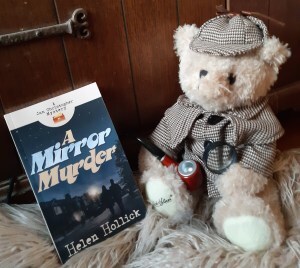 Every cosy crime writter needs their favourite teddy bear…
Every cosy crime writter needs their favourite teddy bear…Most of the Devonshire scenes are made up because I don’t want to inadvertently offend any of my neighbours. The village shop, now, is Community run, in my stories it is a large general-store/post office. The village pub will be today’s pub, but slightly altered to give it a 1970s feel. (Who remembers the popular pub meal of chicken in a basket?) Whatever period, though, life in the country doesn’t change much. Pigs escaped then and escape now. Hay had to be cut and baled then as it does now. In libraries nice people and the not-so-nice still borrow books. New additions have to be processed, returned books put back on the shelves. Today, library assistants watch the clock near closing time just as we did in the ’70s, and I still have occasional nightmares about people trying to climb in through the windows once the main doors have been shut!
Oh, and I do have a favourite teddy bear, just like Jan has.
Debbie: Why are libraries still so important today?
Helen: Why do we need libraries? After all, we have Google and Wikipedia instead.
But as the author, Neil Gaiman, says: “Google can bring you 100,000 answers, a librarian can bring you the right one.”
Libraries are not just ‘book’ places. Today’s libraries have computers for people to use, newspapers, magazines; events such as talks and coffee mornings, fun things for children to do during school holidays. Libraries are somewhere warm to sit and relax. Somewhere to meet pleasant, likeminded people.
There are still many (too many!) people who cannot afford to buy books, or pay a Kindle Unlimited subscription for ‘free’ books. A library can become the hub of a community, a place for entertainment, pleasure and all-important education. It should be totally unacceptable for local councils to close libraries. It is thoroughly shameful that Waltham Forest Borough Council CLOSED South Chingford Library some years ago for lack of funding. The building is still there, but is now offices. A local group started a community library but they are struggling to keep it going. Why is the Council not financially supporting them? Not enough money? Well, think on these quotes:
“An investment in knowledge pays the best interest.” Benjamin Franklin“Whatever the cost of our libraries, the price is cheap compared to that of an ignorant nation.” Walter Cronkite (US Journalist)And don’t forget, libraries need us as much as we need them, so give your support by visiting your local library.
Debbie: My readers love hearing about the writing process. How do you write your books? eg plotter vs pantser, writing by hand or typing, edit as you go or get the first draft out first, where do you write, what time of day do you write, etc.
Helen: Oh, I’m haphazard, I write when I have ideas – and the rest of the time I could win a gold medal for procrastination. Once I’ve got going, I usually write of an afternoon and evening, ensure the draft is saved, then edit it the next day to correct, cut or expand.
I am visually impaired (glaucoma) so writing and reading with wonky sight is a challenge. Thank goodness for Alexa with her verbal assistances, my PC with its big screen, my large-keyed yellow keyboard and my Kindle with its large font. I think about the next scene of a morning while still cosy in bed!
Debbie: What’s your top tip for anyone wishing to start writing cosy mysteries?
Helen: Stop talking or thinking about it – get on and do it!
Debbie: Helen, thank you so much for that in-depth interview – now let’s whet everyone’s appetite for a Jan Christopher mystery with an extract!
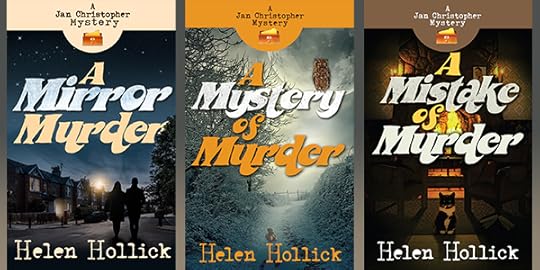 EXTRACT FROM A MISTAKE OF MURDER
EXTRACT FROM A MISTAKE OF MURDER(The third Jan Christopher mystery), giving the flavour of a bus ride in the 1970s)
Was murder deliberate – or a tragic mistake?
January 1972. The Christmas and New Year holiday is over and it is time to go back to work. Newly engaged to Detective Sergeant Lawrence Walker, library assistant Jan Christopher is eager to show everyone her diamond ring, and goes off on her scheduled round to deliver library books to the housebound – some of whom she likes; some, she doesn’t.
She encounters a cat in a cupboard, drinks several cups of tea… and loses her ring.
When two murders are committed, can Jan help her policeman uncle, DCI Toby Christopher and her fiancé, Laurie, discover whether murder was a deliberate deed – or a tragic mistake?
I only just caught the bus – I had to run the last few yards, but the conductor, bless him, delayed those few vital seconds so, puffing like a labouring steam locomotive I made it onto the bus and slumped into a vacant seat.
“Saw you coming, love,” the conductor grinned, “so held it for you. Usual? The Ridgeway?”
I knew him fairly well, as he was often on this evening route of the 69 bus from somewhere-or-other in London to North Chingford. He was a friendly, good-looking man. I think his name was Joe – I’d heard someone call him that once. He often held the bus if he saw me coming. He was nice, friendly and chatty and I did sometimes wonder if he fancied me, which was extremely flattering but I never gave him any reason to be hopeful – too old for me for a start, he must have been in his thirties.
The bus smelled of chips. Someone two seats in front of me was eating them out of the paper wrapping. The aroma suddenly made me realise how hungry I was, and I wondered what Aunt Madge had cooked for dinner.
“Had a good Christmas and New Year?” he – Joe? – asked as he twirled the handle on his ticket machine, rolled out the printed paper ticket and handed it to me.
“Yes, lovely, thank you. You?”
“I was working for most of it. I volunteered for the extra shifts. Need the money. And my sister had Mum for Christmas. She’s elderly, disabled.” He shrugged, “My mum that is, not my sister.”
“If you’re local I could add your mother to our library book delivery service. I take books to the housebound.” I offered.
“She’s not much of a reader. Prefers the telly, them daft soaps: Coronation Street with Elsie Tanner and what’s-his-name? Ken Barlow, but thanks for the offer. That’s where you work, then is it? The library?”
I confirmed I did, and he wandered up to the man with the chips, told him, somewhat gruffly, that passengers were not allowed to eat on the bus – then cheekily helped himself to a few…
A Mistake of Murder, and the Jan Christopher Mysteries are all available from an Amazon near you, or order the paperback from your local bookstore. (Or see if your library will stock them!)
Useful LinksAmazon Universal Link: https://mybook.to/MISTAKEofMURDER
Helen’s Website: https://helenhollick.net/
Helen’s Amazon Author Page: https://viewauthor.at/HelenHollick
Subscribe to Helen’s Newsletter: https://tinyletter.com/HelenHollick
February 15, 2023
The Little Shop of Murders
I’m pleased to announce that a new Sophie Sayers short story, Nowhere to Hide, will be published in a new charity anthology called The Little Shop of Murders on 1st April 2023. By chance, that date marks the sixth anniversary of the publication of my debut novel, Best Murder in Show, Sophie’s first adventure. so I’ll have two reasons to celebrate!
The ebook is now available to preorder, and the paperback will be available on the launch date. Read on to find out more about the project, to which 15 bestselling crime writers have contributed stories. All profits will be donated to support three excellent charities for children, including Read for Good, for which I worked for three very happy years.
Read on to find out more about the anthology, the authors, the stories, and the charities, and how to order your copies.
The BlurbBook shops, boutiques and small businesses are the lifeblood of small towns and villages, but what secrets lie behind those pretty display windows and in the alleyways behind these charming streets?
Step inside for a personal retail experience like no other!
The Little Shop of Murders collects together fifteen superb cozy mysteries written by some of the finest authors in the genre.
All author and publisher profits from the sale of this book go to children’s charities, helping those most in need.
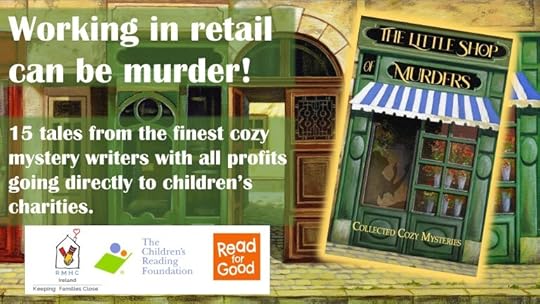
(in alphabetical order by author surname)
The Gift of Dragons by ACF Bookens
Don’t Toy with Me by Diane Kelly
It Was Our Song by Nikki Knight
Blooms and Blackmail by London Lovett
Wild Irish Dreams by Lise McClendon
The Lady of the House by Flora McGowan
Murder in the Bookshop by Rachel McLean
Requiem for a Violin by Geraldine Moorkens Byrne
Nightly Nuisance by Kathryn Mykel
Secondhand Murder by J New
Architect of a Murder by Carlene O’Connor
A Man With No Imagination by Millie Ravensworth
Always and Furever by Eryn Scott
The Forget-Me-Not Antiques Mystery by Victoria Tait
Nowhere to Hide by Debbie Young
As you will probably have guessed by now, all 15 stories are set in high street shops and celebrate local shopping communities. My story, Nowhere to Hide, is set in and around the Hector’s House bookshop, Carol Barker’s village shop, and the repurposed public phone box. Two new characters join regulars from the Sophie Sayers series – arch-rivals as they found free community libraries in neighbouring villages. As a longstanding supporter of the Little Free Library movement, running two free community library boxes on my front wall and one in our village bus-shelter, I had plenty of experience to draw on, and I had great fun writing this story!
The CharitiesThe authors hail from the UK, the USA and Eire, and so the profits will be divided between children’s charities in all three of those countries.
Read for Good – https://readforgood.org/ (UK)Read for Good motivates children to read for fun because we know that loving reading changes lives. Our regular supply of beautiful, brand-new books and visits from professional storytellers, offer children in hospitals, schools and other settings, the chance to escape to other worlds in their imagination. Children in schools are motivated to read using our free Readathon kits, which encourage them to choose whatever they like to read – from comics to classics, and audio books to blogs – all whilst raising money to get books to children in hospital, and books for their school.
The Children’s Reading Foundation – https://www.readingfoundation.org/ (USA)The Children’s Reading Foundation is a national nonprofit with community-based reading foundation chapters and early childhood education programs across the country and in Canada. The foundation serves families, schools and communities by providing proven programs, tools and research to help nurture a child’s development from birth through third grade in ways that foster essential early literacy, math and social-emotional skills.
Ronald McDonald House Ireland – https://rmhc.ie/ (Eire)The mission of Ronald McDonald House Charities Ireland is to provide a Ronald McDonald House to support families whose children are seriously ill in hospital. The Ronald McDonald House provides accommodation and a caring and supportive environment for families whose children are seriously ill and are hospitalised or undergoing medical treatment at Children’s Health Ireland, Crumlin.
The EditorsThe anthology is the brainchild of authors Iain Grant and Heide Goody, who collaborate on many writing projects. Their story in this anthology is by their joint pen-name Millie Ravensworth. They also write separately and together in various genres.
For a Limited Time Only“This is a really important time to release a book like this,” says Heide. “People need entertainment more than ever and raising money to support children in need is another way to put smiles of faces. I’m also delighted that this book highlights the importance of local shops and the community that grows up around the high street.”
For maximum benefit to the charities, the authors have agreed to make their stories exclusive to this charity anthology for one calendar year from the launch date. Only if they all agree at the end of the year, will the anthology remain available. To be on the safe side, pre-order your ebook copy now, or make a note in your diary to order the paperback on 1st April.
How to Order Your Copy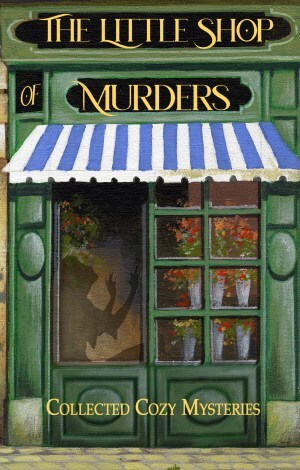 The ebook will be available exclusively for Amazon’s Kindle, and the paperback will be available to Amazon and also to order from bookshops.
The ebook will be available exclusively for Amazon’s Kindle, and the paperback will be available to Amazon and also to order from bookshops.
It will also be available in all Amazon country stores around the world.
If you have any problem obtaining your copy, please let me know and I will point you in the right direction.
February 8, 2023
Now We Are 6(3)
How old will you be in 2023? About to turn 63 as I’m writing this column, I’ve always been grateful for being born at the start of a decade and in the first month of the year. Being a child of the Sixties sounds far more exciting than a child of the Fifties, and it’s very easy to calculate my age at any time.
I have always counted my paternal grandmother especially lucky for being born in February 1900.
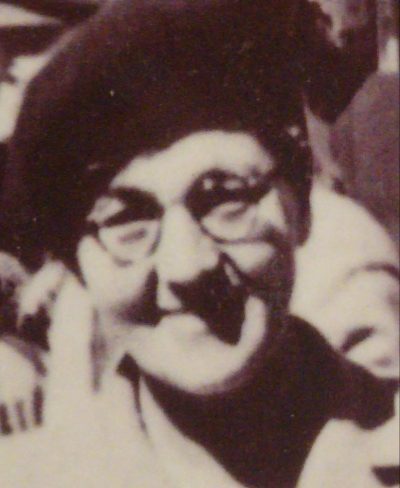 My beloved Grandma – always me + 60
My beloved Grandma – always me + 60I wish I’d been able to bear my daughter three years earlier, in 2000, to pass on the legacy of nice round numbers.
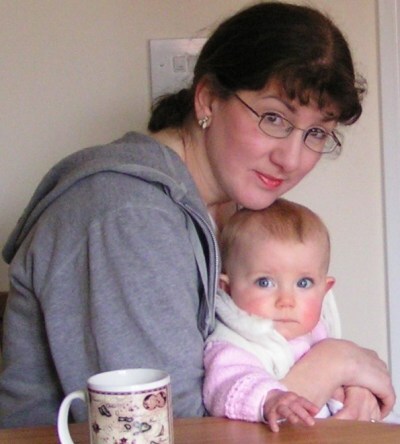 With my daughter Laura when she was less than 1
With my daughter Laura when she was less than 1At the other end of the spectrum, my mother was born on New Year’s Eve. To her irritation, just before each birthday, her father would delight in telling her, “Next year, you’ll be two years older.” An accountant by profession, his other favourite quip was, “A statistician is someone who can have his head in the fridge and his feet in the fire and tell you that on average he is perfectly comfortable” – a great line to give you a sense of perspective.
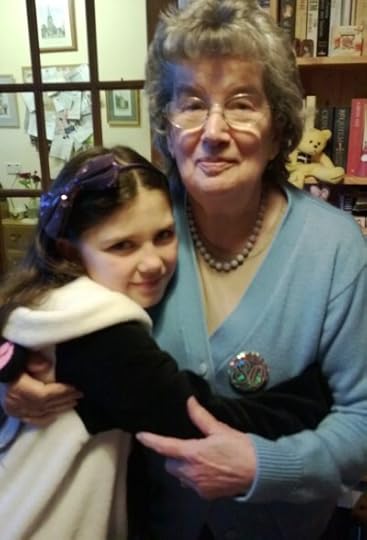 My mum enjoys an 80th birthday hug from my daighter
My mum enjoys an 80th birthday hug from my daighterWhen people ask whether your next birthday is “a special birthday”, they usually mean either a traditional landmark that bestows new legal rights, eg 16, 18, 21, or one that marks the start of a new decade. I’ve always been far more moved by other numbers.
On the eve of my ninth birthday, I lay awake, awed that I was about to embark on my last year in single figures. On my twenty-eighth birthday, I cried because the following birthday would mark the last in my twenties, yet my twenty-ninth and thirtieth passed without a tear.
The traditional dread of my fortieth was dispelled by the death of my first husband ten days before. I was aware of the irony of spending that birthday shopping for something to wear to a funeral. I don’t recall how I spent my forty-second – turning 21 again, ho ho. If I’d been familiar at the time with declaration in The Hitchhiker’s Guide to the Galaxy that 42 was “the meaning of life, the universe, and everything”, I’d probably have celebrated it more memorably.
This year, my celebrations at turning 21 for the third time will consist of a sedate family lunch at a National Trust property. Now there’s age-appropriate! Even so, it’s a number I’ve always loved, since, when I was 7, I decided it my favourite times table answer. Its generous, rounded shape pleased me, as did the neatness of its digits adding up to 9. In numerology, the letters in my full name add up to 63. (They reduce to 9 when you add them together to get your final personal numerology number.)
In short, 63 feels auspicious. In any case, at my age, every extra number notched up feels like a win. We have to take our little victories where we can. Ever the optimist!
This article was originally written for the Tetbury Advertiser’s February 2023 edition
IN OTHER NEWSSOPHIE SAYERS #7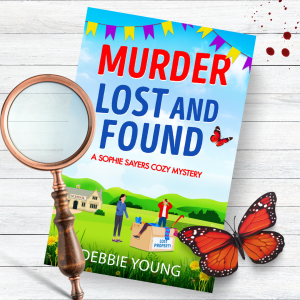 Book 7 in the Sophie Sayers Cozy Mystery series
Book 7 in the Sophie Sayers Cozy Mystery seriesTomorrow will be my book’s birthday! By which I mean it’s publication day for Boldwood Books’ beautiful new edition of the seventh in my Sophie Sayers Cozy Mystery series, Murder Lost and Found.
This story is set at the start of the school summer holidays, when Sophie, clearing out the village school’s lost property cupboard, finds a dead body – which disappears as soon as she summons help. The race is on to find not only the killer, but the body, and to save the school’s reputation. It’s a fun, summery story set in the beautiful Cotswolds.
Available now in ebook and paperback, and hardback, large print and audio are coming soon.
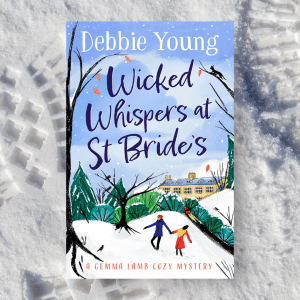 Launching a new book (or in this case a new edition of a previously self-published book) is always a momentous occasion, and this time is particularly special for me, because it means Boldwood Books have now published my complete back catalogue of novels, in both the Sophie Sayers and Gemma Lamb mystery series. This means it’s now on to the next stage of my career, as I can now concentrate on writing brand new novels for Boldwood.
Launching a new book (or in this case a new edition of a previously self-published book) is always a momentous occasion, and this time is particularly special for me, because it means Boldwood Books have now published my complete back catalogue of novels, in both the Sophie Sayers and Gemma Lamb mystery series. This means it’s now on to the next stage of my career, as I can now concentrate on writing brand new novels for Boldwood.
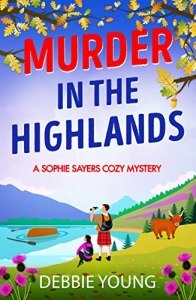 In fact, they’ve already published the all-new third Gemma Lamb novel, Wicked Whispers at St Bride’s, last November, and they will be publish their first all-new Sophie Sayers adventure, Murder in the Highlands on 15th March – more on that soon.
In fact, they’ve already published the all-new third Gemma Lamb novel, Wicked Whispers at St Bride’s, last November, and they will be publish their first all-new Sophie Sayers adventure, Murder in the Highlands on 15th March – more on that soon.
So it’s onwards and upwards for me – and now I’d better get back to my writing desk!
February 1, 2023
Swish, Swish!
After volunteering to help man the Swishing rail at a village event run by our local Women’s Institute (WI) later this month, it occurs to me that perhaps I ought to find out exactly what I am letting myself in for. I know that in this context swishing means swapping clothes, but I’m intrigued by the derivation of the term.
In a word association test, the first words that pop into my head after “swish” are “of the Curtain, (The)” – the title of one of my favourite books when I was a child. Pamela Brown’s classic children’s novel is the first in a series about seven young people who transform a disused chapel into their own theatre company. The sound of the stage curtains swishing open symbolises the success of their project and the lure of the acting life.
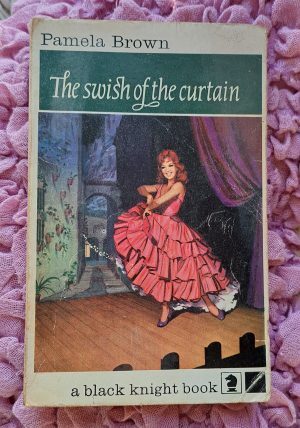 My favourite Swish ever
My favourite Swish everWhen I first read The Swish of the Curtain when I was about 12, I was going through a brief stage-struck phase, attending the Saturday morning drama club at the famous Rose Bruford College of Speech and Drama, literally at the end of the road where I grew up in Sidcup, Kent. The book inspired young actors everywhere, but it also fuelled my more enduring ambition to write fiction, because Brown started writing her novel when she was just 13, finishing it when she was 16..
Like Brown’s book, the Swishing Movement, founded in 2000 by Lucy Shea, also takes its name from the sound of rustling fabric, in this case of the alluring sound of moving silk.
But it’s also tangentially related to “cattle-rustling”, ie cattle theft. The Swishing website defines it as “to rustle clothes from friends”.
 Quite a different kind of swishing – the Beefsteak Raid during the American Civil War (Public domain, via Wikipedia)
Quite a different kind of swishing – the Beefsteak Raid during the American Civil War (Public domain, via Wikipedia)This is because at a Swishing event, no money is exchanged – you just take along old, unwanted fashion items and help yourself to new. Well, new-to-you, anyway.
I don’t suppose cattle-rustlers ever swapped their old unwanted cattle for new ones better suited to their current personal style, so there the similarity of their rustling habits end.
The thesaurus lists “swish” as a synonym for “posh”. That’s also appropriate for swishing events, as items donated should all be of good quality and in good repair, rather than of jumble-sale standard.
Swishing events thus provide a great opportunity to refresh your wardrobe with covetable clothes without spending money or impacting the environment.
So this month, if you’re within reach of Hawkesbury Upton Village Hall on Saturday 18th February and you fancy revamping your wardrobe for free, with swish clothes that may or may not rustle while you move, you know what to do.
Just don’t bring any cattle.
 Any lower-quality garments you’d like to dispose of can be donated in the charity’s collection bin outside the Village Hall or sold on a stall at the Tabletop Sale that takes place the following Saturday 25 February.
Any lower-quality garments you’d like to dispose of can be donated in the charity’s collection bin outside the Village Hall or sold on a stall at the Tabletop Sale that takes place the following Saturday 25 February.
This post was first written for the February 2023 edition of the Hawkesbury Parish News
January 25, 2023
9 Ways Authors Choose Their Characters’ Names
As I was planning my current work-in-progress, Beastly Business at St Bride’s, the fourth Gemma Lamb Cozy Mystery, I realised I’d have to choose the names for three new characters – a task I always enjoy.
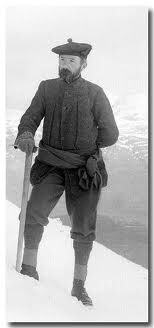 The namesake of Hector Munro – pioneering climber and hillwalker Sir Hugh Munro, who first mapped the Scottish mountains over 3000ft high
The namesake of Hector Munro – pioneering climber and hillwalker Sir Hugh Munro, who first mapped the Scottish mountains over 3000ft highI’ve shared on this blog before how I named Sophie Sayers and Hector Munro in my Sophie Sayers Village Mysteries – you can read them here:
Who is Sophie Sayers Anyway?I’ve even disclosed how my husband and I chose our daughter’s name, which one of my most popular posts ever on this blog. You can read it here:
(Funnily enough, if she’d been a boy, we would have named her Munro!)
I have fun with minor characters’ names too, eg giving Sophie’s self-centred ex-boyfriend Damian Brown the grander stage name of Damian Drammaticas, in homage to veteran BBC news journalist Damian Grammaticas. For years, we’ve loved his name so much (and his work) that a cheer goes up in our house whenever he pops up on the radio or television.
In my Gemma Lamb Cozy Mystery series, set at St Bride’s School, I took delight in christening the headmistress Miss Harnett, which I immediately realised would allow staff and girls to nickname her Hairnet.
I’ll share insights into the origins of other characters’ names in future blog posts. But in the meantime, I thought I’d share how some of my author friends name the characters in their novels. The results of a quick straw poll among my writer chums produced entertaining results. (By the way, I’ve listed links for every author quoted at the end of this post so that you can look them up and find out more about their books.)
1 THE PRACTICAL APPROACHJane Lovering is refreshingly straightforward and sensible: “I choose names based on the background of my characters, their age, and names that were popular when they were born. Jessica Redland takes a similar stance: “I don’t tend to go for quirky stand-out names as I want readers to feel like they’re everyday people.” Clare Flynn has an endless source of inspiration for the names in her historical novels: “Gravestones” was her one-word reply!
 A happy hunting ground for character names? Me a few years ago, in our local parish churchyard of St Mary’s Hawkesbury2 FAMILY FAVOURITES
A happy hunting ground for character names? Me a few years ago, in our local parish churchyard of St Mary’s Hawkesbury2 FAMILY FAVOURITESMany authors raid their family history for inspiration. Tracy Baines gives a heartwarming example: “My character Letty in The Women of Fishers Wharf is named after my grandmother who set me on my writing path by telling me family stories when I was a child.” Similarly, J A Baker reports, “I’m a genealogy fan and use names of my ancestors”. “Family trees are a great source of names,” says Alexandra Walsh. “I’ve used pretty much every family member at some point in a book, first name and surname, although never combined,” says Jessica Redland. “My mum is a big fan of my books, and she gets really excited when she spots a family member’s name in my books. She loved it when she and my dad appeared together as customers in a cafe, although she did tell me I had their ages wrong, and i had to remind her that they were fictional, and I’d only borrowed their names.” Kim Nash made me smile: “There’s in a dog in my latest book called Gladys, after my Nan. I hope she wouldn’t mind!”
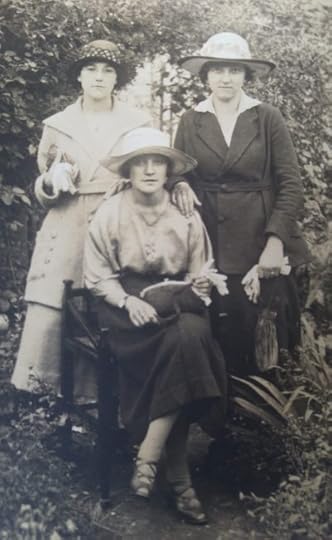 Inspiring ancestors – my Grandma with my great-great-aunts Edie and Becky3 TOP DOGS (AND CATS)
Inspiring ancestors – my Grandma with my great-great-aunts Edie and Becky3 TOP DOGS (AND CATS)Which brings us neatly onto the inspiration that some authors take from their pets. Says Keri Beevis, “Ellie in The People Next Door was named after my cat.” Similarly, Felicity in Find Her Alive honours her tortoiseshell cat; a shapeshifter in For Heaven’s Cakes is called after Beau, her black labrador, and a cowboy in Loving Lydia is named Sam after her ginger cat. Dawn Brookes chose the surname of her cozy mystery protagonist Rachel Prince for the love of her childhood dog Prince, who used to put his head on her knee while she read.
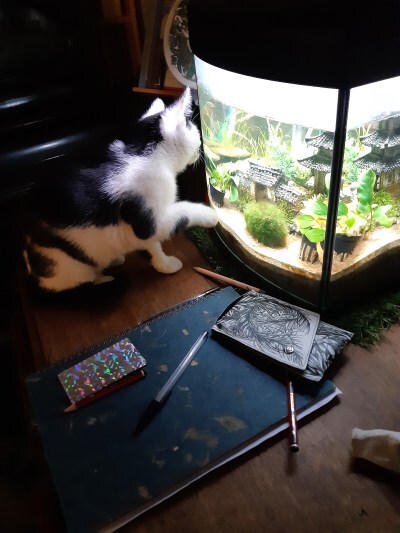 My daughter named every fish in the tank that is mesmerising Bertie (named after Bertie Wooster)4 LET READERS DECIDE
My daughter named every fish in the tank that is mesmerising Bertie (named after Bertie Wooster)4 LET READERS DECIDEInviting readers to designate characters’ names is a popular option, often as the prize in a competition. “I do check they’re happy to be murdered, though!” says Keri Beevis, who has named some fictitious victims this way.
5 RANDOM (MORE OR LESS)Some authors simply pick names at random, although this can cause the occasional hiccup. “I just use whatever pops into my head,” admits Valerie Keogh. “Which is why I had three male characters in one book named David. Fortunately I picked that up and fixed it on second draft!” Phoebe MacLeod “just picks names that I like, that I think suit the age of the character – although I will confess to naming someone after a person I liked from ‘Married at First Sight in Australia’.
6 SWEET REVENGE“Oh, and Fred and Breakfast has a character called Rita who is named after someone I used to work with and disliked intensely many moons ago,” adds Phoebe. Revenge was also sweet for Jessica Redland: “I had a boss who bullied me and made me cry, so I have him appearing in one of my books. I can’t kill anyone off as it’s not the genre I write, but I did get him sacked, which gave me great pleasure!”
7 TRIBUTES TO OTHER AUTHORSAs you’ll know if you’ve read my post about Sophie Sayers – or might have guessed even if you haven’t – I chose Sophie’s surname in honour of my favourite mystery writer of all time, Dorothy L Sayers. (I’d already named one of my cats Dorothy!) Similarly, Jessica Redland pays tribute to the author of the Pollyana books, Eleanor H Porter, in Starry Skies Over Starfish Cafe, giving Porter’s surname to her character Tara, whose father helps her see the positive side of things by playing Pollyanna’s famous Glad Game.
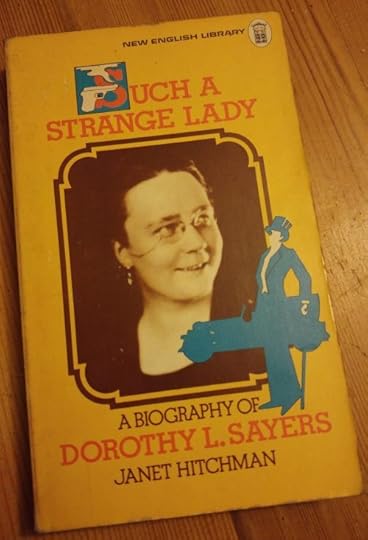 I wonder what Dorothy L Sayers would make of my Sophie?8 THEMED NAMES
I wonder what Dorothy L Sayers would make of my Sophie?8 THEMED NAMESI’m rather taken with the way some authors choose characters’ names to reflect a book’s theme. Movingly, in Jane Davis‘s novel about missing teens, A Funeral for an Owl, all her characters’ names were hybrids of teenagers’ names on a missing persons website.
In The Wind Chime, Alexandra Walsh “tried to use names related to stories and myths about water because the house at the centre of the story is on a cliff.” Sheila Riley‘s themed choices are more sinister: “I give my antagonists the names of poison plants and bitter herbs: Blackthorn, Darnel and Celandine are just some of the names I’ve used for the baddies my my books.” But it’s not all grim. She continues, “In my new Beamer Street series, I have a Mary Jane Starling. Although small and pretty, a starling is feisty, totally determined and territorial – a great name for my heroine.”
Sarah Bennett has themes galore in her books. “In my first series, the three sisters were named after a trio of Greek goddesses as their father was a university professor. In the second, the three friends were all called Elizabeth, as i went to school with three other Sarahs in my class. I chose Elizabeth because it has lots of diminutives. In my third series, they were Arthurian names as there was a legend that the family castle was the original site of Camelot. I had characters named after mermaid legends in Mermaids Point, and in my current series the four older siblings have 70s rock star names, as their parents were a bit rebellious.”
9 HIDDEN MEANINGSAmie McCracken enjoys hiding meanings within her characters’ names. In Leaning into the Abyss, Rhea and her sister Phoebe are named after moons because their mother was an astrophysicist, while the antagonists, the parents of the dead, are named Hurakan, after a Mayan god of storms, and Dolores, Spanish for sorrows.
The heavens also inspired Jean Gill when naming the central character in her historical novel, Song at Dawn. Over to Jean: “The girl wanted to be a troubador, and as with rock stars today, it was common practice to take on stage names. What would have inspired her? What would she have seen,, on the run, desperate, waking from a night in a ditch? I know because I live in Provence and see it every morning: beautiful and an inspiration. “Stella,” I though, coming up with the Latin term for star. Then, thinking of Venus, or the morning star, as we so often call it, I turned to my Occitan dictionary, and Estela de Matin was born.”
Latin is also the inspiration for author Alison Morton who writes alternative history thrillers set in Roma Nova, where the character names follow Latin structures. “Carina derives from cara, the Latin for beloved,” she explains. “While carinare means to grow a shell as a bulwark or protection. My main character certainly has to do that.” But when we first meet Carina, she is living under the anglicised Karen. Only later does the adopt the name of Carina Mitela, taking her Roman mother’s surname.
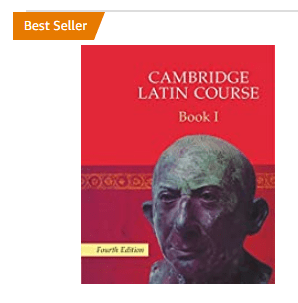 It’s never too late to learn Latin – my old school Latin textbook is currently a bestseller on Amazon – bestseller n the Latin category, anyway!
It’s never too late to learn Latin – my old school Latin textbook is currently a bestseller on Amazon – bestseller n the Latin category, anyway!Now back to my current work-in-progress, where I’ve had fun naming new characters for the next Gemma Lamb Cozy Mystery. In Beastly Business at St Bride’s, in which the girls are encouraged to set up their own businesses (with startling results). I needed a lavish name for an elusive tycoon who sponsors a new girl at the school under mysterious circumstances. Inspired by a byline I’ve often seen in The Times, Sophia Money-Coutts (which I’ve always thought sounded like someone in the pages of a novel), I plumped for Sebastian Goldman-Coutts. Imagine my astonishment when searching online just now for her website to credit her, I read this at the top of her home page:
 Life imitating art imitating life?
Life imitating art imitating life?To find out more about Sophia Money-Coutts, you can visit her website at www.sophiamoneycoutts.com. Or you can look her up on Wikipedia, where you will find that yes, she is related to the private banking family, and that she has a brother, who is a magician named Drummond Money-Coutts. Talk about a name to conjure with….
To find out more about Sebastian Goldman-Coutts, his mysterious ward and his even more mysterious chauffeur-cum-gardener, you’ll have to wait till Beastly Business at St Bride’s is published in the autumn . In the meantime, you can enjoy the first three Gemma Lamb cozy mysteries, with its lively cast of characters with equally outlandish names.
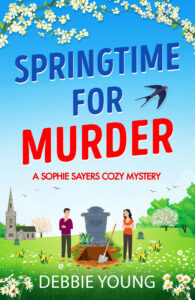 Out this Friday – the new edition from Boldwood Books
Out this Friday – the new edition from Boldwood BooksPlus this Friday sees the launch of the new Boldwood Books editions of the fifth and sixth Sophie Sayers Village Mysteries:
Springtime for Murder – featuring the eccentric old lady, Bunny Carter, so called for her numerous children, and Mrs Petunia Lot, fundraiser for the Cats Prevention League Society Murder at the Mill (previously published as Murder Your Darlings) – featuring the obnoxious but bestselling romantic novelist Marina Milanese, whom Sophie is accused of murdering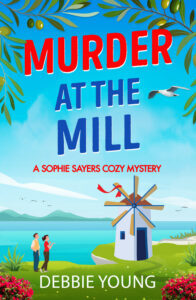 And this one too – book twins for me this week!
And this one too – book twins for me this week!All of my novels are available online and to order from all good bookshops – just let me know if you’re having trouble tracking any down.
Now I’d better get back to Sebastian Goldman-Coutts and friends….
With thanks to my author friends for sharing their top tips for naming characters – clicking their names will take you to websites to tell you more about them:
January 18, 2023
My Writing Goals for 2023
In last week’s post, I shared a summary of my writing year in 2022. This week, I’m declaring my writing goals for 2023, on the basis that publicly declaring intentions makes them more likely to turn into reality.
New Short StoriesI’m pleased to say I’ve already written one new short story in 2023 – helped by a deadline of 31st December 2022! (I thrive on deadlines and have a sign above my desk saying “Nothing makes me more productive than the last minute”.)
This first short story was for a new charity anthology called Little Shop of Murders, edited by Iain Grant and Heide Goody, in which all the stories feature high street shops. Mine is called Nowhere to Hide, and is set in Wendlebury Barrow High Street, home to Sophie Sayers and friends. The action is centred in and around the village shop, the Hector’s House bookshop, and the telephone box as it is converted into a Little Free Library. All of the profits will go to three wonderful charities. I’m really looking forward to sharing this story, which was great fun to write, and also to reading the other contributors’ tales to see their take on the topic. A fun way to start my writing year! More news on this project nearer the launch date, which will be late February.
I’m also planning to write several new Sophie Sayers short stories set at Christmas, to compile with others already written, to create a Sophie Sayers Christmas Compendium in time for Christmas 2023. I had hoped to write them over the Christmas holidays, but ended up relaxing and taking an actual holiday instead!
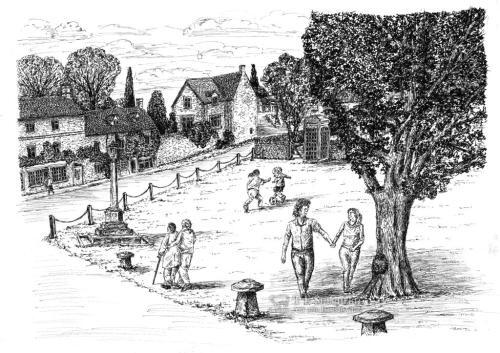 There’ll be a return to Wendlebury Barrow in new Sophie Sayers novels and short stories (illustration by T E Shepherd)New Novels
There’ll be a return to Wendlebury Barrow in new Sophie Sayers novels and short stories (illustration by T E Shepherd)New NovelsMy 13-book contract with Boldwood Books requires me to write two new books for them this year – the fourth Gemma Lamb mystery, Beastly Business at St Bride’s, which is my current work-in-progress, and the ninth Sophie Sayers adventure – working title: Driven to Murder. In the meantime, yesterday I signed off the final proof of the eighth Sophie Sayers novel, Murder in the Highlands, which will be published on 15th March.
 With the new Boldwood Books editions of the first seven Sophie Sayers novels now in production, an all-new eighth,
Murder in the Highlands
, will be launched on 15th March
With the new Boldwood Books editions of the first seven Sophie Sayers novels now in production, an all-new eighth,
Murder in the Highlands
, will be launched on 15th MarchI have two other novels that I’d like to write this year, the first of which will be a second-chance romantic novel, similar in vein to my recent novella Mrs Morris Changes Lanes, but set in Cornwall. I’m keeping the title under wraps just now, but I’m planning to start writing it as soon as I’ve finished my current manuscript. The second will be a shorter book, aimed at children, about a little girl and her grandma. Again, I’m keeping that title a secret until I’m a bit further along with it.
Other Writing-Related GoalsTeachingLast year I became a course tutor for the internationallly renowned organisation Jericho Writers , and I taught two online ten-week courses called “Simply Self-publish” – a little ironic, as this was in the year that I gained three trade-publishing contracts, but I’m still committed to the indie author cause, and I have a great deal of knowledge and experience that I’m happy to share (and to monetise!) Already two of my pupils have self-published terrific novels, The West Rises by SM Davies, and The Paths of Guilt by Max Haven, and and the third has won agency representation, and I couldn’t be prouder of them. If you’re interested in taking the course, you can find more details here:
https://jerichowriters.com/our-services/courses-mentoring/simply-self-publish-course/Talks
I’ll also be giving short one-off talks, both for Jericho Writers and other organisations. I’m looking forward to being a guest speaker at the Romantic Novelists’ Association annual conference in London in August – more details to follow once bookings have opened and the full programme has been announced.Hawkesbury Upton Literature Festival (HULF) Events
I’ve continued to evolve the lit fest I founded for my Cotswold village in 2015, and for 2023 I’m reshaping it yet again. There will be two full-day events, each in a single venue. The first will be a “Festival of Words” celebrating different aspects of language, to be held at our parish church of St Mary’s Hawkesbury. The second will be at the village’s Bethesda Chapel in the autumn and will focus on writers’ research methods and findings. There’ll also be a Christmas Special for an afternoon late November or early December. Full details have yet to be decided, but visit the HULF website www.hulitfest.com for the latest information at any time. (Sorry, I haven’t added any 2023 data there yet, but will soon!)Competition Judging
John Holland, organiser of the Stroud Short Stories spoken word event, has kindly invited me to be co-judge with him of its autumn spoken word event, which involves reading about 100 short stories and choosing 10 for their authors to read at a public event as part of the Stroud Book Festival. This will be the fourth time (I think!) that I’ve co-judged with John, and it’s always terrific fun, and a privilege to get first sight of so many wonderful stories by Gloucestershire and South Gloucestershire authors. Find out more at www.stroudshortstories.blogspot.comJournalism
I’m cutting back a bit on journalism this year as although I enjoy it and can write articles quite quickly, there are still only so many hours in the day, and as you can imagine from (1) above, I need to keep most of my writing time for my fiction. Therefore I’m committing only to writing a quarterly article for Romance Matters , the membership magazine of the Romantic Novelists’ Association, and these articles are based on interview questions, so to be honest, the author I’m interviewing does most of the hard work! Oh, plus of course I’ll still be contributing my usual monthly columns to the two local community magazines that I’ve been writing for since 2010 – the Tetbury Advertiser and the Hawkesbury Parish News . If you’re a regular reader of this blog, you’ll know that I also repurpose those pieces (as the writers’ jargon goes) by turning them into posts on this blog each month.My Writing Life Blog
And speaking of my blog, I timed out towards the end of 2022 and ended up posting very little in November and December. But I always have plenty of ideas for new posts, so this year I’m committing to posting every Wednesday at 2pm UK time. Thus each month there’ll be two posts that started life as my magazine columns, and two or three original posts, depending on how many Wednesdays there are in the month. There will be the occasional posts interviewing other authors or other interesting people (I have a couple of such posts already in the pipeline), but they’ll all be written by me.Social Media
And finally, because all authors need to keep a presence on social media these days – many of their readers expect it of them – I’ll be posting daily, if I can manage it, on my Facebook author page, a few times a week on Instagram, and a couple of times a week on Twitter at @DebbieYoungBN.Time Out
As I noted in last week’s post, I’m lucky to have a good support network of family and friends that make it easier to lead this writing life. I also have interesting, active hobbies, such as bell ringing and singing in our local choir, to take me away from my desk and recharge my batteries. I’d also like to do a bit more travelling this year.
Last year I was enjoyed three short breaks – a long weekend in Berlin with my daughter, a week in Cornwall with my sister and daughter, and a week in Scotland with my husband and daughter. That seemed like a lot of travel after the restrictions of Covid lockdowns, but now I’m getting itchy feet, and would like to take more short trips, even if some are just a day away, to keep me fresh.
 Visiting Berlin had long been on my bucket list
Visiting Berlin had long been on my bucket listI’m already looking forward to a week in Marazion, Cornwall, in March with six writer friends for a writing retreat in a Victorian house opposite St Michael’s Mount, and to a weekend in London in August for the Romantic Novelists’ Association. I’m hoping for a mini-break to Copenhagen with my daughter during her university summer vacation, but I’d also like to travel to some places closer to home, including Hay-on-Wye (England’s National Book Town) and Wigtown (Scotland’s National Book Town). Does that sound like a busman’s holiday? That’s fine by me!
 Staying in Mousehole last year, I could see St Michael’s Mount in the far distance. This year I’ll be staying much closer to it!
Staying in Mousehole last year, I could see St Michael’s Mount in the far distance. This year I’ll be staying much closer to it!FOR YEAR-ROUND BOOK NEWS
Like to keep up-to-date with news of my new books, book-related competitions and special offers all year round? Click here to join my Readers’ Club and receive a free ebook as a welcome gift!
Like to join Boldwood Books’ newsletter so that they can email you when they’re about to launch one of my mystery novels or running special offers? Sign up here.
(You’re allowed to join both if you’d like to!)
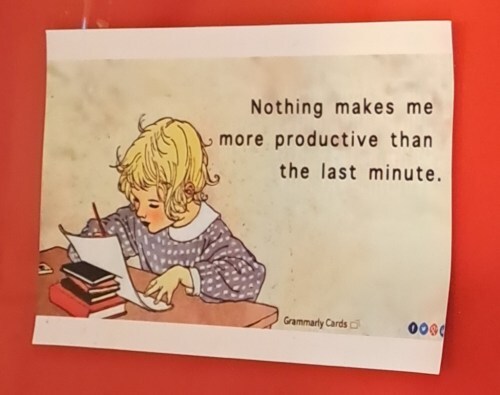 Watch this space!
Watch this space!
January 11, 2023
My Past Writing Year
Before sharing my goals for 2023, I’ve been looking back on what I achieved in 2022 – which was rather more than I expected!
At the turn of the year, when I sat down to set my writing goals for 2023 – more on those in next week’s post – I decided first to list my writing-related achievements in 2022, on the principle that writing a “what I did today” list always makes my next day’s to-do list look less daunting.
Here’s what I came up with (I’ve typed the numbers in figures rather than words to make it easier to follow):
started working with my new agent, Ethan Ellenberg , who kindly offered to represent me late 2021saw the first 3 Sophie Sayers audiobooks published by Saga Egmont , to whom I’ve licensed audio rights for the first 7, a deal negotiated by Ethanagain via Ethan and his team, won 1 German translation deal from DP Verlag for the first 3 Sophie Sayers Village Mysterieswas approached out of the blue by the award-winning publisher Boldwood Books , offering me a 13-book contract for my 2 series of novels, 9 in my back catalogue, plus 4 new ones to be written over the next two years (a contract Ethan then negotiated for me)wrote the first 2 of those new novels, Wicked Whispers at St Bride’s (published November 2022) and Murder in the Highlands (to be published March 2023)ran 4 events for the Hawkesbury Upton Literature Festival (HULF Talks):Romantic Fiction (February), Holiday Reads (June), The World at War (October) and a Christmas Special (November)taught 2 x 10-week Simply Self-Publish courses for Jericho Writers and gave several one-off talks for themwrote 10 “Young By Name” columns for the Tetbury Advertiser (also posted on this blog)wrote 12 columns for the Hawkesbury Parish News (also posted on this blog)wrote 4 articles for Romance Matters , the Romantic Novelists’ Association‘s membership magazinewrote 2 articles for Mslexia magazine, the last in a series of 8 over 2 yearsran bookstalls at 4 live eventsgave 1 live bookshop talk at the Cotswold Book Room in Wotton-under-Edgeopened 1 village fete in Kingswood, Gloucestershire, as a local celebrity author
What Helps Me Achieve
If I’d written those items down as objectives at the start of 2022, I’d have found the list impossibly daunting,
But looking at the list in hindsight makes me more confident about setting my goals for 2023.
Friends and relations might describe me as driven, a self-starter, resilient, hard-working, and curious. These are all qualities I inherited or learned from my parents and grandparents, who are the best role models.
Another advantage is my strong support network. I’m no Thomas Chatterton, scribbling romantically, hopelessly, in his cold lonely garret.
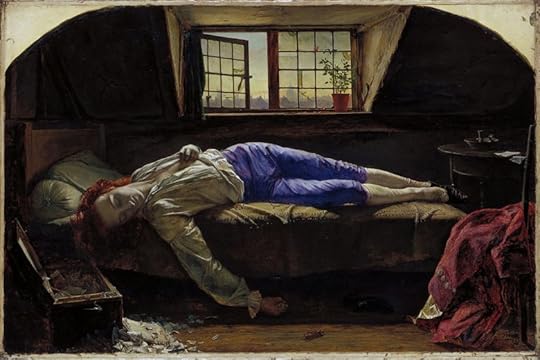 The Death of Chatterton by Henry Wallis (Public domain)
The Death of Chatterton by Henry Wallis (Public domain)I’m lucky to have my parents, brother, sister and nephews within half an hour’s drive away, and a supportive husband and daughter at home.
I have a terrific network of friends all over the world, including wonderful author friends in the Alliance of Independent Authors, the Romantic Novelists’ Association, and the Society of Authors, plus fellow authors published by Boldwood Books.
Closer to home, I live in a vibrant, pretty but not posh or elitist Cotswold village, where I’m able to play a very active role in community life.
I’m very lucky to be relatively secure financially, having paid off my mortgage (and yes, I do realise what a privilege it is to have been able to take out a mortgage to buy my own home). I’m not rich, but for the most part I’m able to live by Mr Micawber’s maxim:
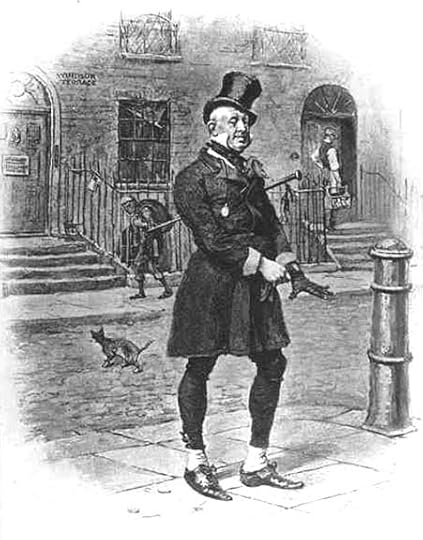 Mr Micawber from Charles Dickens’ David Copperfield, drawn by Phiz (Public domain)
Mr Micawber from Charles Dickens’ David Copperfield, drawn by Phiz (Public domain)“”Annual income 20 pounds, annual expenditure 19 [pounds] 19 [shillings] and six [pence], result happiness. Annual income 20 pounds, annual expenditure 20 pounds ought and six, result misery” – Mr Micawber in David Copperfield
(I confess I also subscribe to his optimistic catchphrase: “Something will turn up“.)
Other things that help keep my spirits buoyant is an estalished set of hobbies that I love, including:
singing with our village choirbell ringing in our parish church of St Mary’s Hawkesburyknitting, crochet and other needleworkreading (at least one book a week, fiction and non-fiction)These activities provide plenty of thinking time and allow my creative mind to wander. They “fill the creative well“, as the saying goes, providing ideas for new stories. I’ve lost count of the number of ways my bell-ringing chums have told me you can murder someone with a bell!
This is not to say I leave a charmed life. I have significant chronic health conditions, including asthma and rheumatoid arthritis, which reduce my energy. I can no longer use a conventional keyboard. But it’s in my nature to light a candle rather than curse the darkness, and I’m thankful for ergonomic keyboards and voice recognition software.
I’m sharing these thoughts not to show off, but to encourage you when setting your goals for 2023. Aim high. Believe in yourself. Give yourself the chances you deserve.
Whatever you plan to do in 2023, I wish you a happy, safe and fulfilled new year. Next week I’ll be telling you how I plan to spend mine.
IN OTHER NEWS The eighth Sophie Sayers Cozy Mystery is due to launch on 15th March 2023 and is now available to pre-orderMy eighth Sophie Sayers Village Mystery,
Murder in the Highlands
, is now in production and due to be published on 15th March by Boldwood Books.I’ve just finished planning my fourth Gemma Lamb Cozy Mystery,
Beastly Business at St Bride’s
, which will be published by Boldwood Books later this year.Last night I submitted a new Sophie Sayers short story,
Nowhere to Hide
, for a charity anthology,
The Little Shop of Murders
, edited by Iain Grant and Heide Goody, to be published on 14th February. (More news on that soon.)Boldwood Books launches its new editions of Sophie’s fifth and sixth adventures,
Springtime for Murder
and Murder at the Mill (previously Murder Your Darlings) on 28th January, and the seventh,
Murder Lost and Found
, on 15th February – which means all my back catalogue will once more be on the market, not only in ebook and paperback as before, but also in audiobook, large print and hardback.
The eighth Sophie Sayers Cozy Mystery is due to launch on 15th March 2023 and is now available to pre-orderMy eighth Sophie Sayers Village Mystery,
Murder in the Highlands
, is now in production and due to be published on 15th March by Boldwood Books.I’ve just finished planning my fourth Gemma Lamb Cozy Mystery,
Beastly Business at St Bride’s
, which will be published by Boldwood Books later this year.Last night I submitted a new Sophie Sayers short story,
Nowhere to Hide
, for a charity anthology,
The Little Shop of Murders
, edited by Iain Grant and Heide Goody, to be published on 14th February. (More news on that soon.)Boldwood Books launches its new editions of Sophie’s fifth and sixth adventures,
Springtime for Murder
and Murder at the Mill (previously Murder Your Darlings) on 28th January, and the seventh,
Murder Lost and Found
, on 15th February – which means all my back catalogue will once more be on the market, not only in ebook and paperback as before, but also in audiobook, large print and hardback.AND FINALLY…
As I set this post up the night before it is due to go live, I’ve just discovered my latest book, Wicked Whispers at St Bride’s, the third in my Gemma Lamb Cozy Mystery series, is currently an Amazon bestseller, at #264 in the UK Kindle charts. The first in that series, Dastardly Deeds at St Bride’s, is also currently sporting a bestseller sticker. Not a bad way to start my new writing year!

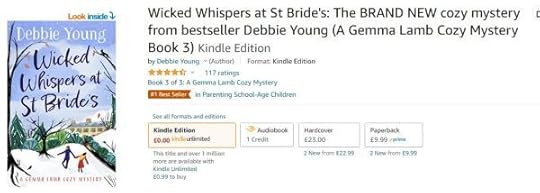
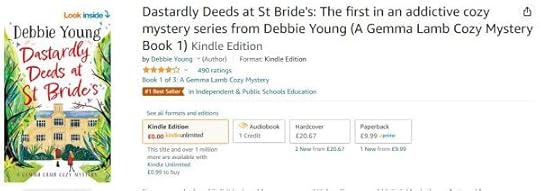
January 4, 2023
Dream On
My first blog post of 2023 is the column I wrote for the January issue of the Hawkesbury Parish News – a very important institution in the life of a little Cotswold village like mine!
I’m the kind of optimist who not only sees the glass as half-full, but is jolly grateful to have a glass, and assumes it must be made of the finest crystal.
That’s not to say I’m oblivious to darker times. But when life seems grim, I unleash a handy collection of mantras that make me feel better.
“Better to light a candle than curse the darkness”, I tell myself. (Clichés are clichés for a reason, you know.)“If winter comes, can spring be far behind?” (Thank you for that one, Percy Bysshe Shelley – especially handy as winter is my least favourite season.)If I’m in a musical frame of mind, I simply channel D:Ream and play “Things can only get better” on a loop in my head.But as this new year dawns, I’m feeling wary. For the last few years, I’ve started every January thinking, “This has got to be a better year than the last one”. Then along comes something worse.
What a run of disasters we have had lately: Trump, Brexit, Covid, more Covid, the war in Ukraine, and all the economic and political fall-out those crises induced. Not to mention ever-stranger weather, indicative of frightening climate changes.
With apologies to Samuel Johnson, who described second marriage as “the triumph of hope over experience,” experience is threatening to triumph over hope.
Yet my inner optimist will out, and as I list those disasters, over which I had no control, bar the right to vote and to get vaccinated, I realise it’s still within my power to make 2023 a better year in small ways.
So 2023 will be the year that I will vow never to run out of teabags, or milk for my morning tea…
 Bonus point: if you buy M&S Luxury Gold teabags in bulk, they work out cheaper than Everyday teabags!
Bonus point: if you buy M&S Luxury Gold teabags in bulk, they work out cheaper than Everyday teabags!or the cats’ favourite treats, Dreamies:
 Downside: the Mega Tub might make my three cats a bit tubby too
Downside: the Mega Tub might make my three cats a bit tubby tooAnd if I’m setting the bar that low, doesn’t that mean things can only get better? Let’s live in hope.
Wishing you a new year full of whatever makes you happy.
In my next post, I’ll be reviewing my writing achievements in 2022 and sharing my writing plans for 2023.
PS My new year’s resolution is to publish a new blog post every Wednesday! Let’s see how that goes…
December 31, 2022
Off the Hook for Books
This final post of 2022 was originally written for the December 2022/January 2023 edition of the Tetbury Advertiser , which was published in the run-up to Christmas
This month my to-do list includes a much-needed weeding of my groaning bookshelves, in the hope that Father Christmas, who knows me well after all these years, will bring me a pile of lovely new books.
Every room in my house contains bookshelves, except the utility room and the larder. (I’ve slipped up there.) Each shelf is jam-packed with rows of books, with more laid on top horizontally to fill all available airspace. It’s clearly time to declutter. But which books should I keep and which jettison?
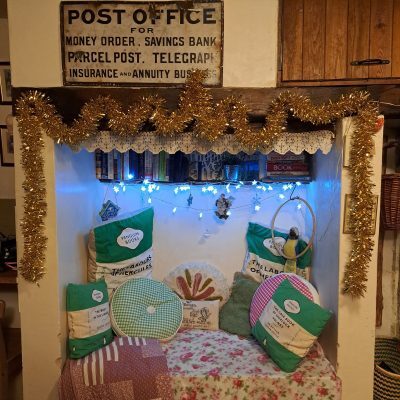 My reading nook houses my shelf of books about books
My reading nook houses my shelf of books about booksMy shelves contain many books that I have yet to read, because a literal TBR pile would be taller than my house. They also store books I expect to reread, including some too fragile to withstand further handling. For sentimental reasons, I’m hanging onto my 1970s paperbacks of the complete works of Dorothy L Sayers and George Orwell, for example, which made a huge impact on me in my teens.
 My growing collection of books and about Dorothy L Sayers has a shelf to itself
My growing collection of books and about Dorothy L Sayers has a shelf to itselfAlthough I own a Kindle, that doesn’t relieve the pressure. I use it only for travelling, and in between times it serves as a cloak of invisibility for ebooks. I’d always rather read a physical book.
Every time I start this exercise, or any other act of decluttering, I consider the advice of Japanese tidiness guru Marie Kondo. (I confess her methods transformed my tea-towel drawer.) In her first book, The Life-Changing Magic of Tidying, she recommended keeping so small a quantity of books that you’d need only one small shelf. Her rationale for such ruthlessness was that if you missed a book you’d disposed of, you could always buy it again. It’s true that books are easily accessible and affordable – a relatively cheap treat-to-self even in a recession – but that’s not an approach I’d apply to other material possessions, such as clothing, jewellery or furniture. Do I really want to follow it for books?
I’m keen not to do Ms Kondo a disservice, because her philosophy is inspired by her Shinto faith. So before writing this article, I went to find my copy of her book to check exactly how many books she recommends keeping. Then I remembered I disposed of it during a previous book purge. (Sorry, Marie – you’ve been hoist by your own petard.)
A Google search led me to her website, where I was pleased to discover she has revised her advice. Is it because she has now published so many books in multiple languages that, if applying her own rule, she couldn’t keep a souvenir copy of each one? “Keep as many books as you like,” is her latest advice, “as long as they spark joy.”
Well, that’s me off the hook from decluttering my bookshelves. Just don’t tell Father Christmas.
Wishing you endless sparks of joy this Christmas, and a contented New Year filled with good books.
POSTSCRIPT
Father Christmas did bring me some very lovely books – a biography of Richmal Crompton, creator of Just William…
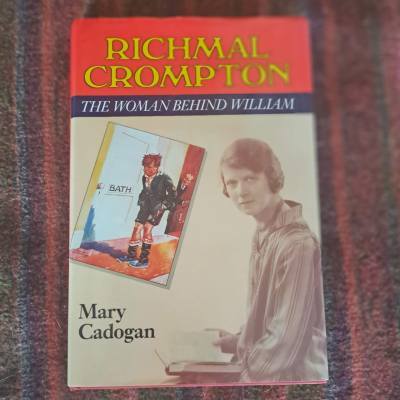
…and a beautiful Folio Society box set of Dorothy L Sayers books.
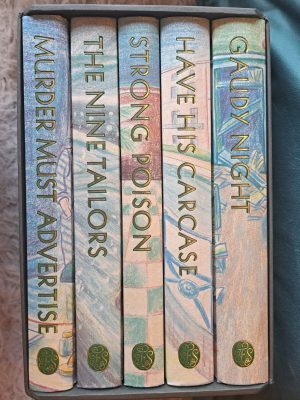

I think I’m going to need a bigger DLS bookshelf…
December 30, 2022
Just Keep Singing
Tight writing deadlines in the last few months have meant I’ve got way behind on my blog – so please excuse me if I now have a quick catch-up to shoehorn in two articles I wrote for the Tetbury Advertiser in November and December, before I run out of 2022! This article was written for the November 2022 issue of the Tetbury Advertiser. I’ll post the December one tomorrow.
A recent free concert at St Mary’s, Tetbury by the St Cecilia’s Singers provided a lightning tour of four hundred years of Anglican choral music, from Tallis to Tavener. Listening to the music, I gazed up at the soaring windows and ceiling, remembering from school history lessons that Gothic architecture was designed to draw the eye heavenward. St Mary’s high box pews reminded me, as box pews always do, of earthly coffins. Memento mori all round, then.
Actually, I really like box pews. On this cold, crisp night, they made effective draft excluders. In the current energy crisis, perhaps we should box in our sofas at home, creating little pockets of warmth to keep us toasty as temperatures fall.
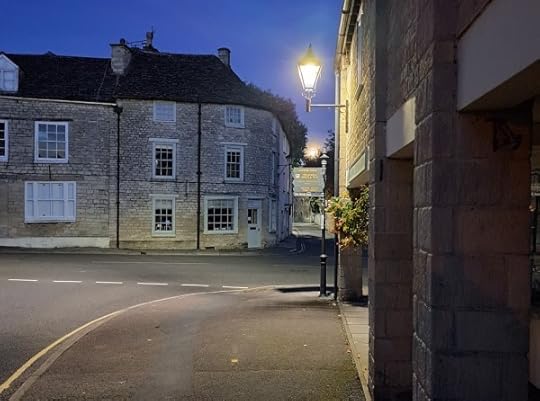 On the way to Tetbury church, passing under the Narnia-style streetlamp, with the rising full moon beyond
On the way to Tetbury church, passing under the Narnia-style streetlamp, with the rising full moon beyondDriving home beneath a bright near-full moon with the choir’s exquisite harmonies resonating in my head, I fell to wondering which pieces of music would define me. I don’t mean in the “favourite tracks” style of Desert Island Discs, a programme I’ve adored since childhood, when I thought the guests really was despatched to a desert island after the show, but which songs are most significant in my life.
My parents tell me that at the age of three, I used to go around the house humming Mozart’s Eine Kleine Nachtmusik, thanks the Readers’ Digest boxed set of classical music LPs that they constantly played for comfort during the long cold winter of 1963. Their hopes that I might prove to be an infant prodigy were short-lived, however. My musical career peaked at the age of six when I was chosen to sing the first verse of “In the Bleak Midwinter” for my infant school’s carol service as a duet with a boy called Patrick. It’s still my favourite carol, and the words of the last verse always makes me tear up.
Fast forward to the birth of my daughter, by elective Caesarean for medical reasons, when the surgeon invited us to bring a music CD to play during the procedure. We chose Canteloube’s “Songs of the Auvergne”. Maybe that’s why my daughter sings cheerfully and non-stop around the house.
When she grew up and needed me less in the evenings, I joined a village choir and took up church bell ringing. Both activities provide a sense of connection not only with my late grandfather, a church choirmaster, and my great-grandfather, an accomplished bell ringer, but with church communities that go back even further than the four centuries covered by the St Cecilia Singers’ concert. This was never more apparent than when we rang and sang in September to commemorate the passing of the Queen and to celebrate the proclamation of the King.
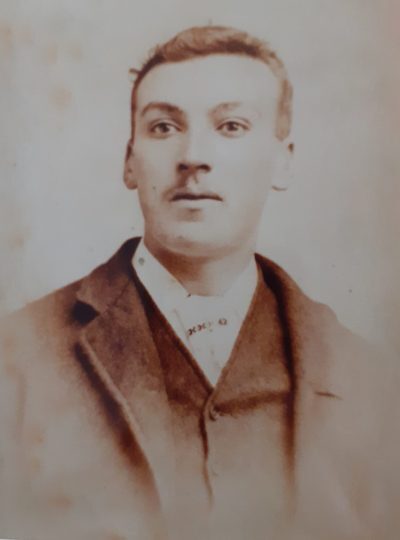 My great-grandfather, the bell ringer
My great-grandfather, the bell ringer
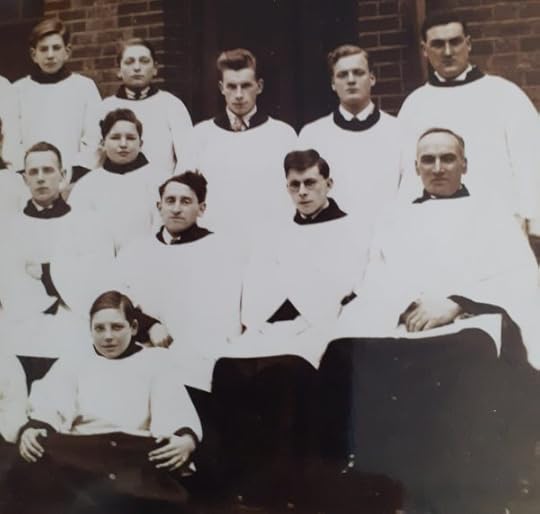
Being part of such a timeless tradition brings with it a sense of optimism – the feeling that whatever else changes around us, all will be well. So if you’re feeling glum at the onset of winter, embrace whatever music makes you feel better.
Just keep singing.
Drawing on my own musical experience, I plan to write Sophie Sayers stories about the Wendlebury Barrow church choir and the Wendlebury Bell Ringers in 2023 – watch this space!
In the meantime, Boldwood Books are publishing their new editions of Sophie’s fifth and sixth adventures in January (Murder at the Well – previously Murder by the Book – and Springtime for Murder), the seventh (Murder Lost and Found) in February, and an all-new eighth adventure, Murder in the Highlands, in March!


